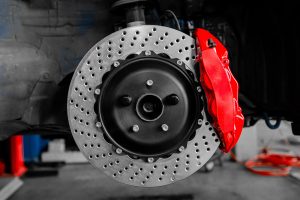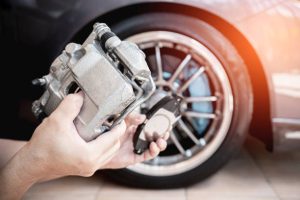When it comes to your vehicle’s safety, brake components are the most critical. While brake pads and rotors often get the most attention, the brake caliper is the part that ensures the pads press firmly against the rotor to generate stopping power. If a caliper begins to fail, braking efficiency drops, which not only affects performance but can also put you and others at serious risk.
Unfortunately, failing brake calipers often go unnoticed until the damage has already spread to other parts of the braking system. This article explains the key signs of a failing brake caliper, why these issues are dangerous, and what you should do if you encounter them.
What Does a Brake Caliper Do?

The brake caliper houses pistons that push the brake pads against the rotor when hydraulic pressure is applied through the brake fluid. It’s essentially the “muscle” of the braking system, converting fluid pressure into mechanical force.
Without functioning calipers:
-
Brake pads won’t engage properly.
-
Braking force will be uneven.
-
The vehicle may take much longer to stop.
Common Signs of a Failing Brake Caliper
A failing caliper can present itself in many ways. Knowing the symptoms can help you catch the issue before it compromises safety.
1. Vehicle Pulling to One Side
-
If a caliper seizes, one brake pad may remain clamped against the rotor.
-
This creates uneven braking, causing your car to pull left or right.
2. Unusual Noises While Braking
-
Grinding, squealing, or clunking can indicate a sticking piston or worn pad.
-
Metallic grinding often suggests the caliper isn’t releasing pressure.
3. Reduced Braking Performance
-
Longer stopping distances.
-
A “soft” or spongy brake pedal feel.
-
Vehicle struggles to stop during emergency braking.
4. Fluid Leaks
-
Calipers contain seals that can wear or crack over time.
-
Leaking brake fluid lowers hydraulic pressure, making braking dangerous.
5. Uneven or Rapid Brake Pad Wear
-
Sticking calipers cause one pad to wear faster than the other.
-
If you notice uneven pad thickness, the caliper may be the culprit.
6. Brake Warning Light
-
In some vehicles, persistent hydraulic issues trigger a dashboard warning.
Symptoms Checklist
| Symptom | Possible Cause | Risk Level |
|---|---|---|
| Car pulling to one side | Stuck piston or slider | High |
| Grinding or squealing | Seized caliper, worn pads | High |
| Soft brake pedal | Fluid leak or piston issue | Critical |
| Brake fluid on the ground | Damaged seal | Critical |
| Uneven pad wear | Sticking caliper | Moderate |
| Burning smell near wheels | Overheating brakes | High |
Why You Shouldn’t Ignore Failing Calipers
Driving with a faulty brake caliper is not just an inconvenience—it’s a serious safety hazard. Here’s why ignoring the issue is dangerous:
-
Increased Stopping Distance → reduces your ability to avoid collisions.
-
Uneven Braking → may cause skidding, especially in wet conditions.
-
Damage to Other Components → rotors, pads, and wheel bearings suffer excessive wear.
-
Brake Failure Risk → in extreme cases, brakes may fail completely.
Causes of Brake Caliper Failure
Several factors can shorten the lifespan of calipers:
-
Corrosion from road salt and moisture.
-
Heat buildup during heavy braking.
-
Old or contaminated brake fluid causing seal damage.
-
Lack of lubrication on sliding pins (floating calipers).
-
Worn dust boots allowing dirt and moisture inside.
How to Diagnose a Bad Brake Caliper
You can spot early caliper issues by doing the following:
-
Visual inspection → look for leaks, cracks, or uneven pads.
-
Check wheel temperature → one wheel hotter than others suggests a stuck caliper.
-
Listen while braking → grinding or dragging noises are red flags.
-
Test braking response → does the car pull or feel weak under braking?
If any of these checks raise concerns, professional service is recommended.
Repair vs. Replacement: What’s the Best Option?
Sometimes a failing caliper can be rebuilt with new seals and pistons, but in many cases, full replacement is the more reliable solution.
| Repair | Replacement |
|---|---|
| Cheaper short-term | Higher upfront cost |
| May extend life temporarily | Restores braking performance fully |
| Risk of recurring issues | Longer-lasting and safer |
When replacement is needed, you can buy Brake Caliper online to find high-quality options that match your vehicle.
Preventing Caliper Failure

Like most car components, brake calipers last longer with proper maintenance. Here are some tips:
-
Flush brake fluid every 2 years to prevent corrosion.
-
Lubricate guide pins during brake service.
-
Inspect seals and boots for cracks or wear.
-
Check for uneven pad wear regularly.
-
Replace pads and rotors on time to avoid excess strain.
Conclusion
The brake caliper is a vital but often overlooked component of your car’s braking system. Recognizing the early signs of failure — such as pulling, unusual noises, fluid leaks, or uneven wear — can save you from expensive repairs and dangerous driving conditions.
Ignoring caliper problems risks your safety, increases stopping distance, and can cause severe damage to surrounding parts. To ensure reliability and peace of mind, replace failing calipers promptly.
If your car shows symptoms of caliper trouble, don’t delay — inspect the braking system and, if necessary, buy Brake Caliper online to restore your vehicle’s stopping power.